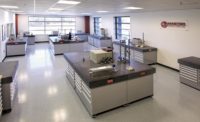In June, three student teams from the Chicago Tech Academy (ChiTech) presented their innovations in front of an audience of manufacturing industry professionals at the 2016 SAP Manufacturing Industries Forum. The nonprofit, four-year high school in Chicago was founded in 2012 with the mission of inspiring, educating and, connecting young people—especially minority and low-income students interested in science, technology, engineering, and mathematics (STEM) pursuits—to re-imagine the future of manufacturing.
The winning ChiTech presentation focused on “saving lives in the digital enterprise.” The team was surprised to learn that even in our hyper-connected digital age, critical patient information cannot be easily transmitted from an ambulance to a hospital. They learned that most ambulance phones can only make outgoing calls and have just one button, as opposed to a keypad that could speedily relay information like the patient’s height, weight, allergies, and vital signs to the hospital on the ride over. Thus the team proposed inserting wires under ambulance gurneys with Apple iPads attached to quick-scan the patient’s face and body, then transmit the patient’s information to the nearest hospital, as well as the second-nearest hospital and the hospital holding the patient’s medical records, if applicable, in less than 60 seconds.
This rapid and innovative solution is emblematic of the next generation of quality engineers, which has been called the iGeneration. And for good reason: the iGeneration’s panoply of user-intuitive devices has made Cloud-based thinking and fluency in the language of Big Data akin to instinct.
Of course, ChiTech is not the only institution committed to restoring and re-energizing the severely depleted manufacturing workforce in the United States. In the Carolinas alone, the Center for Precision Metrology, run by Edward Morse at the University of North Carolina at Charlotte, and STEM Premier, a LinkedIn-like group for students headed by CEO John Welch that partners with the South Carolina Manufacturers Alliance on a S.C. Future Makers initiative, are making headway. In addition, organizations like the American Society for Nondestructive Testing (ASNT) and the American Society for Quality (ASQ), among many others, are bolstering their student outreach programs with the same mission in mind: to ensure that the future of manufacturing is in capable and endlessly creative hands.
For this article, Quality spoke with David Clayton, executive director of Greenville Technical College Center for Manufacturing Innovation (CMI) in Greenville, SC, and Andrew Parker, director of governmental affairs at the Arkansas State Chamber of Commerce, regarding their efforts to shore up the next generation of quality engineers. Here’s how they’re doing it.
Quality: The number one goal of the CMI, opening in Fall 2016, is to “close the manufacturing skills gap.” Was the Center conceived with this goal in mind?
David Clayton: The CMI is a reflection of the strong partnership between [Greenville Technical College’s five-campus system] and manufacturers. In fact, the idea originated with employer needs. Around 2010, as the economy showed signs of improvement, advanced manufacturing employers voiced concerns about finding an adequate supply of skilled workers in order to take advantage of opportunities. The idea for the CMI grew out of these discussions.
How does the CMI intend to accomplish this goal?
Clayton: We are working to increase the pipeline by ensuring that what we teach meets employers’ hiring needs, and showcasing advanced manufacturing’s high-tech tools and rewarding careers so that young people, their parents, and career changers realize the potential.
We are providing education in a modular format so that working adults can stop out and re-enter easily, and we are contextualizing basic skills courses so that adult learners can improve in the basics as they are immersed in the manufacturing curriculum. We emphasize apprenticeships and internships, and combine classroom education with valuable on-the-job experience, so that students can apply what they’re learning as they also develop soft skills, and so that employers can evaluate potential future employees.
Starting in 2017, firms will have a chance to pose real-world manufacturing challenges to joint teams of Greenville Technical College Manufacturing Honors College students and Clemson University students, bringing the theoretical and hands-on knowledge of both groups to bear on pressing problems. This is a first of its kind, innovative program that will give manufacturing employers an early look at a diverse set of our best and brightest students.
The Be Pro Be Proud campaign launched in March 2016, also with the goal of closing the manufacturing skills gap. What kind of resources and training does the campaign provide for students, teachers, and influencers to accomplish this goal?
Andrew Parker: In addition to the Be Pro Workshop tour to engage student participation in skilled trade professions, a significant part of the Be Pro Be Proud workforce initiative is its online presence on BeProBeProud.org. Within, we have designated areas titled “Find Training” and “Find Jobs,” where users can narrow results by the educational institutions and employers that match their desired career path and zip code. It’s really designed to be a comprehensive hub for students, educators and employers.
How is the campaign stimulating interest in younger people to join the manufacturing workforce at this critical juncture (Baby Boomers aging out of the profession in record numbers)?
Parker: The initiative’s Be Pro Workshop has made tour stops across [Arkansas] at middle schools, high schools and several fairs and festivals this spring and summer. The idea is to use engaging, interactive stations that adequately reflect what it’s really like to work in a skilled trade. Inside, students can:
- Watch videos detailing 12 skilled professions, their job responsibilities, and average wages for each.
- Learn from a set of Cummins interactive videos that detail diesel mechanics and how their engines work to power trucks, buses, bulldozers, cranes, etc.
- Participate in a Skills Challenge, an interactive touch wall that tests hand-eye coordination.
- Compete against one another to complete the Plumbing Pathway.
- Test electricity, heat, and a variety of other construction site facets.
- Practice welding techniques and compare against industry standards with a Lincoln Electric virtual welding simulator.
- Program cuts for parts with a Haas Automation CNC cutting simulator.
By appropriately conveying a day-in-the-life for each of these 12 professions, the intent is to spur more interest among students at the age where they’re considering whether to pursue continued education or training.
It’s worth noting that the Arkansas State Chamber did comprehensive research on the skills gap issue in Arkansas, conducting focus groups with legislators, employers, parents and students. Only one in three parents said they would encourage their child(ren) to pursue technical careers and it became evident that a general lack of awareness existed about their opportunity. The travelling Be Pro Workshop brings a tangible feel of these professions to the public with an interactive display.
What is the significance in focusing on seventh through ninth grade students, as opposed to say, older high school students?
Parker: It’s about changing that perception at an early age, so that maybe as those ninth graders move through high school they can participate in elective and extracurricular activities that match a skilled trade career. It’s still important for those high schoolers closer to graduation, as they weigh the pros and cons of college; but the earlier we can convey our messages to this audience, the better.
What do you see as the biggest obstacle to recruiting a new generation of workers to replace those who are retiring?
Clayton: Manufacturing generally ranks near the bottom of interest inventories. In some cases, that’s because of perceptions of manufacturing as representing a dirty shop floor, but in other cases, it’s simply lack of interest. At the CMI, visitors will cross a bridge [and] look down on a high bay lab space where students are engaged in real-world training using CNC machines, robots, 3D printers, and more. They’ll see what today’s manufacturing environment really looks like, as they hear about the education required and the salaries and opportunities [that await].
Does the Be Proud Be Proud approach involve reconfiguring the students’ perhaps dated perception of what “manufacturing” is?
Parker: Absolutely. The fact is that manufacturing careers now are not the dirty, dangerous, low-paying careers they once were. They’re high-tech and high-wage and the entire Be Pro Be Proud initiative is aimed at communicating that to students looking to choose a career path.
Our online videos and the Be Pro Workshop really illustrate these facts not only for the manufacturing sector, but for others also facing a growing skills gap (e.g. computer programming, commercial truck driving, diesel mechanics, etc.). It’s our goal to change the conversations and perceptions surrounding skilled trades in Arkansas. Out of the starting gate, companies across Arkansas are willing to pay wages north of the state’s average per capita income; and with the diligence and determination expected of professionals, young people can enjoy six-figure salaries, in many cases in under a decade. And this says nothing about the success that can be achieved by working into management or ownership positions.
The CMI boasts a series of firsts. It’s the first of its kind collaboration with a technical college and research university in the U.S, the first additive manufacturing partnership with Renishaw at a technical college, and the first “open” manufacturing lab in SC. The Manufacturing Honors College is also “the first of its kind.” In your view, why are these firsts significant, and will there be more firsts to come?
Clayton: These firsts are significant because with the Center for Manufacturing Innovation, we are not just opening a new building so that we’ll have more space for what we’ve always offered. Instead, we have re-imagined education for advanced manufacturing so that we can impact the skills gap, allowing employers to succeed and students to access opportunities. I do expect more firsts to come because we will never be satisfied with the status quo. Our name contains the word “innovation” so that we can focus on creating the workforce of the future.





